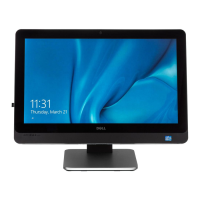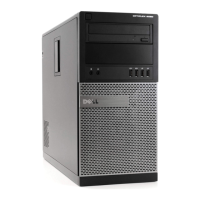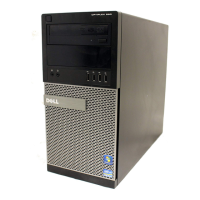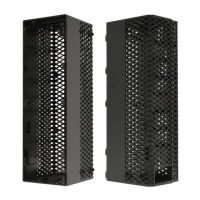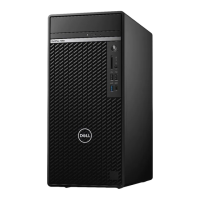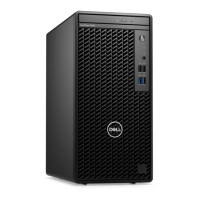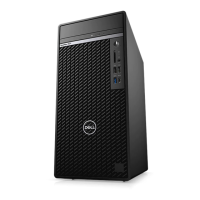Do you have a question about the Dell OptiPlex 9010 Mini-Tower and is the answer not in the manual?
Safety guidelines and preparation steps before working inside the computer.
Instructions on how to properly shut down the computer.
Steps to follow after completing internal work on the computer.
Lists the tools required for component removal and installation procedures.
Procedures for removing and installing the computer's outer cover.
Steps to remove and install the chassis intrusion switch.
Steps to remove and install the wireless local area network card.
Steps to remove and install the front panel bezel.
Steps to remove and install expansion cards in the system.
Guidelines and steps for removing and installing memory modules.
Steps to remove and install the coin-cell battery.
Steps to remove and install the hard disk drive.
Steps to remove and install the optical drive.
Steps to remove and install the internal speaker.
Steps to remove and install the power supply unit.
Steps to remove and install the CPU heat sink assembly.
Steps to remove and install the CPU.
Steps to remove and install the system cooling fan.
Steps to remove and install the thermal sensor.
Steps to remove and install the power switch.
Steps to remove and install the front I/O panel.
Steps to remove and install the system motherboard.
Identification and description of system board components.
Configures the order of devices for booting the system.
Lists the keys used for navigating the system setup menus.
Details various configuration options within the system setup.
Instructions for updating the system's BIOS.
Explains the function and configuration of system board jumpers.
Information on setting, assigning, changing, and disabling system passwords.
Instructions on running the ePSA diagnostic tool for hardware testing.
Interpreting power LED states for diagnosing computer issues.
Explains beep codes used to diagnose startup problems.
Lists and explains common error messages encountered by the system.
Details processor types, cache, memory type, speed, and capacity.
Details integrated and discrete video, audio, and network adapter specs.
Details system chipset, DMA, interrupts, BIOS, and expansion bus specs.
Details PCI card slots, drive bays, and external/internal connectors.
Details power ratings, physical dimensions, and environmental limits.
Safety guidelines and preparation steps before working inside the computer.
Instructions on how to properly shut down the computer.
Steps to follow after completing internal work on the computer.
Lists the tools required for component removal and installation procedures.
Procedures for removing and installing the computer's outer cover.
Steps to remove and install the chassis intrusion switch.
Steps to remove and install the wireless local area network card.
Steps to remove and install the front panel bezel.
Steps to remove and install expansion cards in the system.
Guidelines and steps for removing and installing memory modules.
Steps to remove and install the coin-cell battery.
Steps to remove and install the hard disk drive.
Steps to remove and install the optical drive.
Steps to remove and install the internal speaker.
Steps to remove and install the power supply unit.
Steps to remove and install the CPU heat sink assembly.
Steps to remove and install the CPU.
Steps to remove and install the system cooling fan.
Steps to remove and install the thermal sensor.
Steps to remove and install the power switch.
Steps to remove and install the front I/O panel.
Steps to remove and install the system motherboard.
Identification and description of system board components.
Configures the order of devices for booting the system.
Lists the keys used for navigating the system setup menus.
Details various configuration options within the system setup.
Instructions for updating the system's BIOS.
Explains the function and configuration of system board jumpers.
Information on setting, assigning, changing, and disabling system passwords.
Instructions on running the ePSA diagnostic tool for hardware testing.
Interpreting power LED states for diagnosing computer issues.
Explains beep codes used to diagnose startup problems.
Lists and explains common error messages encountered by the system.
Details processor types, cache, memory type, speed, and capacity.
Details integrated and discrete video, audio, and network adapter specs.
Details system chipset, DMA, interrupts, BIOS, and expansion bus specs.
Details PCI card slots, drive bays, and external/internal connectors.
Details power ratings, physical dimensions, and environmental limits.
| Processor | Intel Core i3/i5/i7 (3rd Generation) |
|---|---|
| Chipset | Intel Q77 Express |
| Form Factor | Mini-Tower |
| Expansion Slots | 1 x PCIe x16, 1 x PCIe x1, 1 x PCI |
| Networking | Gigabit Ethernet, optional Wi-Fi |
| Storage | Up to 2TB HDD or 256GB SSD |
| Graphics | Integrated Intel HD Graphics 2500/4000 or optional discrete graphics |
| Operating System | Windows 7/8/10 |
| Ports | USB 2.0, USB 3.0, HDMI, VGA, DisplayPort, Ethernet |
| Optical Drive | DVD-ROM, DVD-RW |
| Dimensions (H x W x D) | 6.9 x 17.5 |

